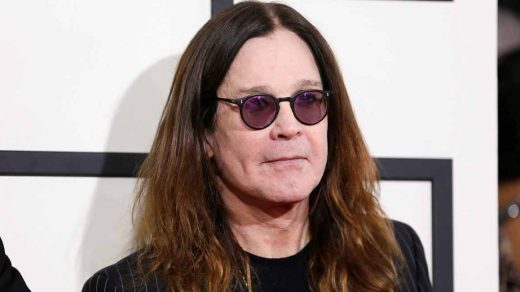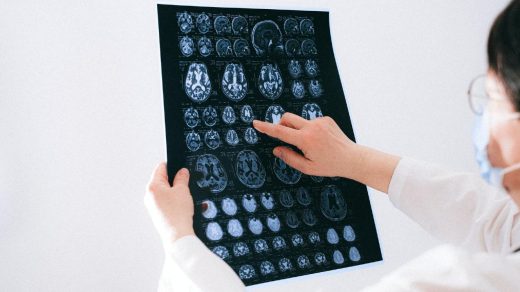Whether people are fast asleep or reading a book, the neurons in their brains hum a tune that only they can hear.
Neurons communicate with one another by firing a series of electrical pulses in specific frequencies. Like a high-pitched note, some pulses come in quick succession. These typically happen when people focus intently on a specific task. Other times, such as during meditation or sleep, the pulses are few and far between, like a lullaby. Scientists read out these different neural oscillations as waves ranging in frequency from delta waves at the low end to gamma waves at the peak.

Isabelle Buard uses magnetoencephalography to measure how music therapy affects the brain in people with Parkinson’s disease.
Credit: Isabelle Buard
“When you’re sleeping, your frequencies of your brain are actually slowing down so that you can get peaceful. You can get rested,” said Isabelle Buard, a neuroscientist at the University of Colorado Denver. “When you do something more intense — you write, you think, you hear, you move — those are actually generic bursts of high frequency oscillations.”
These neuronal melodies change depending on a person’s actions, but they also change in the context of disease. Buard studies how these different neural oscillations change in the brains of people with Parkinson’s disease. Specifically, she wants to know whether another kind of tune can improve the fine motor symptoms associated with Parkinson’s disease: music therapy. With positive preliminary data, Buard and her team are investigating whether music therapy can improve Parkinson’s disease symptoms in a clinical trial. They are also using a brain imaging method called magnetoencephalography (MEG) to see how music therapy modulates the neuronal symphony playing throughout the brain.
How did you become interested in studying the neural oscillations involved in Parkinson’s disease?
The brain has fascinated me since I was 15 years old, and I always told my mom that I wanted to be a person who studied it. When I started my graduate research, I worked with mice as a model to understand how the brain develops and how neurons make connections, but I really wanted to look at overall brain networks in humans and do something that would be more relevant to human disease.
I’ve always been interested in fine motor movements like how we move our fingers, how we coordinate the movements of both of our hands at the same time, and what controls those fine motor movements. I realized that there are a lot of neurological diseases that impair fine motor skills, but there’s unfortunately not a lot of attention paid to those symptoms. Many of the medications that doctors give these patients do not actually help tremendously with fine motor symptoms.
At one point, the head of the lab I was in at the University of Colorado Denver was the movement disorders neurologist Benzi Kluger, and he had a collaboration with the inventor of the Neurologic Music Therapy (NMT) clinical system, Michael Thaut at the University of Toronto, who is now my friend and collaborator. At that time, I was just a worker bee in the lab, and Thaut suggested that we look at the neural oscillations in the brain associated with rhythm and finger movements in people with Parkinson’s disease and in older adults without Parkinson’s disease. I was involved in the recruitment, data collection, and analysis (1). By that point, Kluger had some other research interests, and he realized that this research fascinated me, so he allowed me to lead the project moving forward.
How do you measure neural oscillations in the brain?
When most people talk about brain imaging, they think about functional magnetic resonance imaging, which involves looking at blobs of activity in the brain. We, however, use a technique called MEG, which allows us to image the communication flow from one brain region to another. When different neuronal populations in the brain fire together, they generate electrical currents. Going back to Faraday’s Law from high school physics class, electrical currents generate magnetic fields. The great thing about those magnetic fields is that they can penetrate through the layers of the brain and the skull like cutting through butter. This means that we can put a sensor just outside the head and record those magnetic fields noninvasively. It’s very quiet, and we can image the brain quickly. We get a very accurate and high-resolution idea of where and when information flows in the brain. We can look at activities in one part and then 10 milliseconds later in another part, and we can see neurons switching from high frequency to low frequency oscillations in different parts of the brain.
How does music therapy affect people with Parkinson’s disease?
Parkinson’s disease weakens dopaminergic pathways in the brain, which affects the pathways involved in motor function. When patients take dopamine replacement medication, it improves some of the motor networks such as those involved in gross motor movements like walking, but it doesn’t help fine motor movements. We think that music therapy can help mobilize alternate networks or strengthen some that are functional to improve fine motor movements like grasping an object.
How does your music therapy clinical trial work?
We image people’s brains using MEG before they receive any therapy to get a baseline understanding of their neurophysiology. We also do a variety of clinical tests to evaluate their fine motor movements such as grasping, dexterity, and how wide they can open and close their hands. We have an untreated control group, a group that receives standard occupational therapy, and two groups that receive two slightly different forms of music therapy (2).

Patients in Buard’s clinical trial practice playing along to a rhythm using castanets.
credit: istock.com/Vanish_Point
The patients in the music therapy groups use musical instruments like the piano or the ukulele with the goal of improving their fine motor movements. For example, we have a weighted keyboard, and to get a big sound, people must push down very hard on the keys. For people with Parkinson’s disease, each of their fingers may have a different level of strength or stiffness, so we use a weighted keyboard to work each hand and finger independently. We also do some exercises that require people to coordinate their two hands on the piano. We structure the exercises to start out very simple and to get more complicated over the course of the five-week treatment period.
We also have some castanets that patients can use to play along to a beat, and we have them grasp and move differently shaped objects including cups, pens, and coins to a rhythm to work on different subtle movements. At the end of the sessions, they get a few minutes to improvise on the piano at whatever tempo they are comfortable with. Even though people are pretty shy at the beginning, they enjoy this part of therapy a lot when they get more comfortable with it. When the participants are not at one of their three weekly 45-minute sessions, we give them daily music-driven exercises to do at home for 10 minutes. At the end of the five weeks, we use MEG to image their brains again.
We set up this music therapy protocol so that the exercises will have some translation to everyday life. For example, every single activity would help people cut their food, open a drawer, write something on a piece of paper, tie their shoes, button their shirts, and so on.
How do the two types of music therapy differ?
NMT relies on the music therapist or a metronome to give the patient cues in terms of what rhythm to perform the exercise. In the other type, Music Supported Therapy (MST), we ask the patient to generate the rhythmic cues on their own while working with the musical instruments. MST is similar to a situation where if we were teaching a kid to ride a bike, we would hold the bike for a while and then let go. Whereas for NMT, the therapist holds the back of the bike throughout the whole five weeks of the therapy.
We think about music therapy as potentially being a patient centered medicine in the long run.
– Isabelle Buard, University of Colorado Denver
We think that the brain networks mobilized during those two different interventions are going to be very different, and that could inform whether one method is better than the other for a particular patient. No two people with Parkinson’s disease are the same. They all have distinct patterns of symptoms and brain activity. We want to know what the brain oscillations look like before the intervention and how the brain reacts to this music intervention. Does it produce more beta or more gamma oscillations? Does it produce more connections and lead to more communication between certain areas of the brain that are or are not impaired? The Holy Grail would be that maybe people with a certain baseline activity in their brains will respond better to one therapy, but another group will respond better to the other therapy. We think about music therapy as potentially being a patient centered medicine in the long run.
When will you have data to share from this clinical trial?
We’re still collecting data, but my goal is to finish data collection by November 2023. Then we can start doing the analysis. Because this is a clinical trial, we have to publish our results within one year. In this lab, we also take pride in sending our patients results. We tell them which group they were in and the results of their group overall. It’s meaningful for them to know what happened.
What has been the most rewarding part about working on this clinical trial so far?
The Parkinson’s disease population is a great group of people to work with. They have a lot of enthusiasm. We’ve had a lot of positive feedback, and we’ve even had people referring their friends to the study because they enjoyed it so much. It’s really been a joyful experience.
What do you plan to do next in your NMT research?
I’m interested in exploring the different aspects of music and how things like tone, rhythm, and feelings of pleasure in response to music affect rehabilitation of fine motor functions. Is there an aspect of music that is more potent, or do we need everything combined? I hope to identify distinct neural pathways that different components of music tap into. Based on that, we could think about treating people with Parkinson’s disease or other disorders in very different ways. If we knew, for instance, that tones in music affect one pathway, we could have people do tone-based music therapy. If we can figure out what the brain has in terms of resources that music can tap into, we can use music as medicine for the brain.
This interview has been condensed and edited for clarity.
References
- Buard, I. et al. Auditory entrainment of motor responses in older adults with and without Parkinson’s disease: An MEG study. Neurosci Lett 708, 134331 (2019).
- Buard, I. et al. Randomized controlled trial of neurologic music therapy in Parkinson’s disease: research rehabilitation protocols for mechanistic and clinical investigations. Trials 22, 577 (2021).
This news item came from: https://www.drugdiscoverynews.com/musical-medicine-for-parkinson-s-disease-15805



